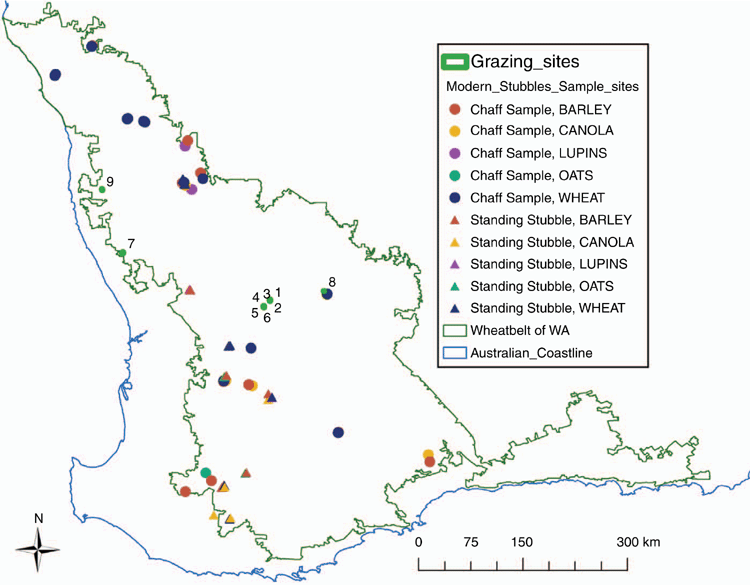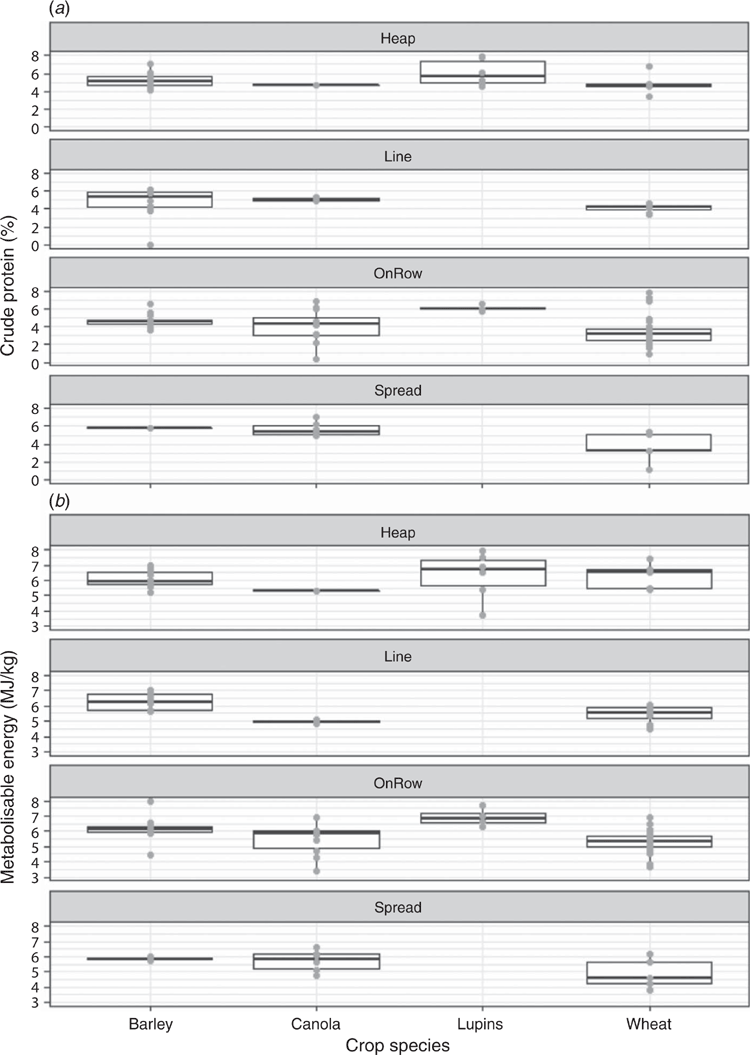The value of stubbles and chaff from grain crops as a source of summer feed for sheep
Dean T. Thomas A B , Andrew F. Toovey A , Elizabeth Hulm A and Gonzalo Mata A
A B , Andrew F. Toovey A , Elizabeth Hulm A and Gonzalo Mata A
A CSIRO Agriculture and Food, Floreat Laboratory, Private Bag 5, Wembley, WA 6913, Australia.
B Corresponding author. Email: dean.thomas@csiro.au
Animal Production Science 61(3) 256-264 https://doi.org/10.1071/AN20127
Submitted: 2 April 2020 Accepted: 4 August 2020 Published: 10 September 2020
Journal Compilation © CSIRO 2021 Open Access CC BY-NC-ND
Abstract
Context: Modern crop stubbles provide an important source of feed for sheep during summer but can vary widely in their feeding value due to Genetics × Environment × Management interactions during crop growth, and how chaff is managed at harvest. Stubbles are difficult to assess for grazing value, due to the heterogeneity of forage components (e.g. stem, leaf, grains), which means that livestock producers rely on their observations and experience to manage sheep grazing stubbles.
Aims: To provide current information on the feeding value of stubbles, and to establish better methods for estimating stubble feeding value.
Methods: In the present paper, we report the results of sheep grazing wheat-stubble paddocks and a survey of the nutritive value of standing stubbles and chaff lines and piles of grain crops (including wheat, barley, canola and lupins) from crop paddocks in the mixed-farming region of Western Australia.
Key results: Without supplementation, wheat stubbles provided 50–100 dry sheep equivalent grazing days per hectare, before the estimated metabolisable energy (ME) intake of sheep fell below maintenance. This was influenced by ewe body condition score, where sheep of lower body condition gained more weight on stubbles (89 g/day higher weight gain per unit lower body condition score). Estimated ME content of edible chaff (leaf, fine stem and seed sheath or pod, excluding main stem and grain) was 5% higher in barley, 19% higher in lupin, and 5% lower in canola, than in wheat chaff, which was 5.9 MJ ME/kg DM.
Implications: While the grazing value of modern stubbles is variable, they have an important role in the seasonal feedbase by providing several months of feed during summer. Chaff by itself does not meet the energy or protein requirements of livestock, so a high-protein grain supplement (e.g. lupins) is necessary to maintain non-lactating ewes fed only chaff. The increased use of chaff lines and piles at harvest, primarily for weed control, provides a new opportunity to fill feed gaps in sheep and cattle enterprises if the material can be transported and stored efficiently, or if grazed in situ, as is common practice.
Additional keywords: chaff cart, feedbase, feed gaps, mixed farming.
Introduction
The provision of feed over summer is a key consideration for livestock businesses in the agricultural region of southern Australia, due to the typical summer dry period and few perennial plants that are suitable forage options. Historically, crop stubbles have been an important source of summer and autumn feed for mixed farms in the Mediterranean-type climate zones of southern Australia (Roberts and Paterson 2001; Robertson 2006). This timing coincides with ewe mating and gestation, so access to crop stubbles is important for sheep reproduction when other forage sources are limited. However, the feed value of crop stubbles is difficult to estimate because as little as 10% of biomass is edible components such as grain, leaf and germinated weeds (Purser 1983). Typically, the bulk of stubble biomass is poorly digestible plant stems (straw). Further, the high-quality components may rapidly deplete over summer by populations of endemic fauna (such as ants, mice and birds; Landau et al. 2000), and are also susceptible to nutrient leaching following summer rain events. This variable and dynamic nature of feed from stubbles makes nutritional outcomes for sheep grazing them highly variable and difficult to predict. The decision to move livestock from a stubble to other feed sources (often fresh stubbles) is critical because poor timing may result in over or under utilisation of the feed resource, poor livestock performance and welfare outcomes and deterioration in the productive capacity of the land (Pickup and Stafford Smith 1993; Brennan et al. 2006). Despite this, the duration of grazing events through a series of stubble paddocks remains largely subjective and is usually determined through visual flock monitoring. Due to the heterogeneity in crop stubble components, subjective assessment of feed will likely result in less precise tactical management of paddock rotations and supplementary feeding.
Experienced farmers may understand the feeding value of their stubbles, with knowledge of how crop type and growing conditions, soil type, harvesting methods and post-harvest weather interact to affect feed quality of stubbles. There have been previous efforts to integrate this complexity through developing decision support models (e.g. Orsini 1990; Moore et al. 2007); however, recommendations for stubble grazing in southern Australia are largely based on data collected several decades ago (Arnold et al. 1978; Mitchell 1979; Pearce et al. 1979; Purser 1983; Aitchison 1988). These data were generated from historical crop cultivars that are now rarely grown and harvested using the machinery of that time, and the lack of data to parameterise such models was acknowledged (Orsini and Arnold 1986). There is also little information on new (or increasing) crop species, such as canola, particularly in lower-rainfall areas. Changes in crop-harvest management that affect feeding value of stubbles include (1) higher-yielding crop varieties (~0.5% yield increase per year; Fischer 2008), (2) larger harvesters (~4% wider per year; Fuchs et al. 2015), (3) the increase in proportion of farm cropped (~2% more land cropped per year in Western Australia since 1980; Bell and Moore 2012), (4) a higher proportion of canola stubbles (~30% more canola harvested per year in Western Australia since 2000, Wilkinson 2017), and (5) changes in the management of chaff such as an increase in the use of chaff carts to collect threshed material at harvest (~3% increase per year in chaff collected at harvest was predicted, Walsh et al. 2017). Despite the changes in the characteristics of stubbles over previous decades, many of the key questions being asked by farmers over this period remain relevant and still need to be addressed, including how the carrying capacity of stubbles can be better estimated to allow greater precision and certainty in livestock management. The aim of the present paper was to investigate changes in the feeding value of crop stubbles as they become depleted with grazing, on the basis of data from several crop-grazing experiments. Further, we conducted a field survey to evaluate the variability in the nutritive value of stubble components among crop types, and associated with chaff aggregation or dispersal at harvest.
Materials and methods
So as to understand drivers of the performance of sheep grazing modern stubbles, we conducted several grazing studies and surveyed a wide range of crop stubbles that had undergone different harvest management methods. The field experiments were conducted across the mixed farming region of Western Australia in 2008 and 2014–2016 (Fig. 1, numbered symbols). The south-western agricultural region of Western Australia has a Mediterranean-type climate, with a high proportion of annual rainfall occurring between April and September (Rossiter 1966), with long-term average annual rainfall at the sites ranging from 325 to 489 mm.
Animal and grazing management
In collaboration with mixed crop and livestock farmers, nine wheat-stubble paddocks of commercial size for the region (64–311 ha) were grazed by groups of Merino ewes from one of the existing farms mobs. Grazing of crop stubbles commenced between early December and mid-February, varying among years, and lasted for 4–8 weeks (Table 1).

|
Initially, and then at either 1- or 2-week intervals for the duration of the experiments, sheep were yarded, fasted overnight and a pre-selected core group of at least 20 sheep per paddock (identified by numbered tags and coloured ‘spray mark’) were weighed and condition scored. While grazing, the sheep had water ad libitum from a single dam or reticulated trough located in each of the paddocks. The CSIRO Floreat Laboratory Animal Ethics Committee approved protocols for the experimental work (organisational references; 0715, 1306, 1411 and 1503). For all grazing trials, the selected stubbles were harvested such that chaff was spread from the harvester, and not managed into lines or piles.
Stubble biomass, composition and nutritive value
Samples of stubble biomass for analysis were taken either from (1) chaff lines and heaps that had been aggregated during the 2018/2019 harvest, (2) the previously mentioned field experiments of livestock grazing stubble paddocks, conducted between December and March, or (3) a survey of ungrazed standing-crop stubbles made from 17 to 21 December 2018. At least four quadrats (each 0.25 m2) were collected from each paddock where standing stubbles were sampled. The collection sites were generally well distributed within the southern agricultural region of Western Australia, although the central eastern region was under-represented and there were no project samples collected from the far south-eastern region (Fig. 1). The 2018 growing-season rainfall at the study sites ranged from 101.4 mm (Lake Grace) to 505.3 mm (Boyup Brook). Sampling sites were selected randomly within paddocks, or randomly within specific target areas of the paddock. Details of how each form of stubble material was sampled are as follows:
-
Chaff heap. Material was collected from random locations and depths within heaps of chaff that had been collected in chaff carts.
-
Chaff line. Chaff material (excluding standing stubble components) was collected from lines of chaff aggregated behind the header as the crop was being harvested.
-
Off row. Entire aboveground material collected at randomly selected locations between chaff rows, in paddocks where chaff was aggregated in rows.
-
On row. Entire aboveground material collected at randomly selected locations on chaff rows, in paddocks where chaff was aggregated in rows.
-
Spread. Entire aboveground material collected at randomly selected points in cropped areas of the paddock, in which harvested and threshed chaff passing through the header had been dispersed mechanically on the basis of the design of the harvester.
Samples were dried at 60°C for 48 h, before processing. Samples containing soil residue were thoroughly cleaned using 600-μm Laboratory test sieve (Endecotts, London, UK). Residues of other plant species or plant material from the previous cropping season were also removed. Then, all samples were sorted, and material was categorised into large, medium, small and seed (grain) components. In doing so, a 2-mm Endecotts stainless-steel laboratory test sieve was used to separate the small (fine) plant portion, whereas the large, medium and seed portions were manually separated. Broadly, chaff fractions were made up of the main stem (large), fine stem, leaf, sheaths and pods (medium), very fine leaf and stem, spikelet and hull, and weed seeds (small) and unharvested grains, including seeds taken from unthreshed heads (seed). All subsamples were weighed, then dried at 60°C for a further 24 h and ground using a 1-mm-diameter grinder (Foss Analytical Co., Hilleroed, Denmark). Fractions were kept separately for individual analysis, where there was sufficient material of each component. Where there was insufficient material of a component for nutritional analyses, only weight data were recorded. The nutritive value of the samples collected was analysed in the CSIRO Floreat Nutrition Laboratory. The plant nutritive-value analyses were predominantly conducted using near-infrared reflectance spectroscopy, with wet chemistry conducted on a subset (15%) to allow validation. The validation of the near-infrared reflectance-spectroscopy prediction of the nutritive value of stubble material showed that this method was very accurate, with r2 values for DM digestibility (DMD) and crude protein (CP) of 0.970 and 0.993 respectively. For the subset of samples, in vitro DMD, DMD (in vitro DMD corrected using in vivo standards), CP, fibre (acid detergent fibre (ADF), neutral detergent fibre) and ash analyses were performed as described by Norman et al. (2010). Metabolisable-energy (ME) content was calculated as megajoules (MJ) of ME per kg of feed DM (M / D) = 0.172 DMD – 1.707 (CSIRO 2007).
Metabolisable energy intake
The daily ME intake (MEI) of the ewes was calculated using the method of Thomas et al. (2009), where liveweight gain or loss, in combination with the animal’s current liveweight, are used to predict the MEI of the animal.
Statistical analyses
A multiple linear-regression analysis was conducted to examine the relationships between estimated MEI (dependent variable) and the number of sheep grazing days on stubble, and initial sheep liveweight and body condition score (independent variables). Both sheep grazing days (ewe days/ha, not adjusted for liveweight) and dry sheep equivalent (DSE) grazing days (DSE days/ha, 1 DSE = 8.9 MJ ME/day; Thomas et al. 2009) variates were used in analyses. For linear-regression analyses for variates predicting MEI, sheep grazing days (unadjusted for ME requirements) was included as a fixed effect because initial sheep liveweight was included in the statistical model. For fitting an exponential decay function for grain remaining in the paddock, we used the variate DSE grazing days (DSE days/ha, standardised for liveweight). Analyses were conducted using R version 3.6.2 statistical package (https://cran.r-project.org/bin/windows/base/old/3.6.2/, verified 19 August 2020).
Results
Unharvested grain
The quantity of unharvested grain in the wheat stubbles varied widely among paddocks (107 ± 80.2 kg DM/ha, n = 9). Changes in the amount of grain remaining as paddocks are grazed was represented by an exponential decay function (root mean-square error, 17.0 kg/ha), where unharvested grain in wheat stubbles (Ut, kg/ha) at a given number of grazing days (DSE days/ha) was predicted by the following formula;

where U0 (kg/ha) is the initial amount of unharvested grain in the paddock. Gt (grazing days) is the duration livestock have been in the paddock standardised for ME requirements, or the product of duration of grazing (days) and DSE stocking rate (DSE/ha).
A similar decay curve was observed for green plant material that was present for one stubble-grazing experiment at Tammin in 2008; however, there was no detectable amount of live plants in other experiments for a decay function to be determined. A decay function for grazed green plants seems to be likely during summer in a Mediterranean-type climate, as green plant growth does not usually continue. After the initially rapid growth of germinating crop and weeds with a summer rain event, plant growth slows as the soil dries out quickly at this time of the year, unless there is a subsequent summer rain event, which is unlikely. Across all of the field studies, no change in the biomass of wheat stem material was found despite clear changes in the structure of the stubbles associated with trampling.
Metabolisable energy intake
Estimated MEI for sheep grazing wheat stubbles decreased in relation to the number of sheep grazing days spent on the stubbles (–0.345 MJ ME/sheep.day; P < 0.001; Fig. 2). Sheep reached maintenance intake when estimated MEI was ~12.2 MJ ME/sheep.day, which was between 50 and 100 DSE grazing days per hectare (Fig. 2). Sheep with a higher initial condition score had lower liveweight gain over the duration of grazing stubbles by 89 g/sheep.day per unit condition score (P < 0.001). Initial liveweight did not affect estimated MEI (P = 0.221).
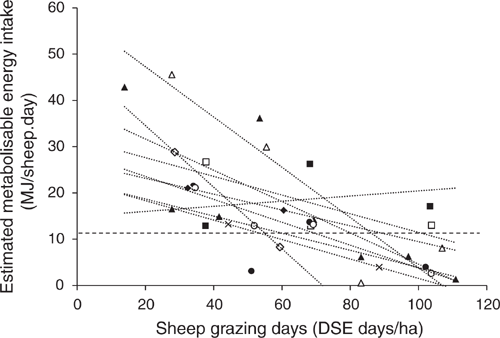
|
Nutritive value of stubble samples
The proportion of stubble fractions (large, medium, small, seed) depended on the source of stubble sample, both due to crop type and harvest method. Samples from chaff heaps had the lowest proportion of the large component (main stems), ranging from 8.0% to 12.4%, while quadrat samples taken from the area between chaff lines (off row) had the highest proportion of large (40.7–52.0%; Fig. 3). The proportion of small material also tended to be highest in chaff heaps for barley and wheat, but was lower in lupins and canola, which had very similar component ratios in chaff heap material, with a high proportion (~80%) of medium chaff. The proportion of grains (seed) in barley chaff heaps (1.8%) and lines (4.3%) was higher than for other crops (Fig. 4).
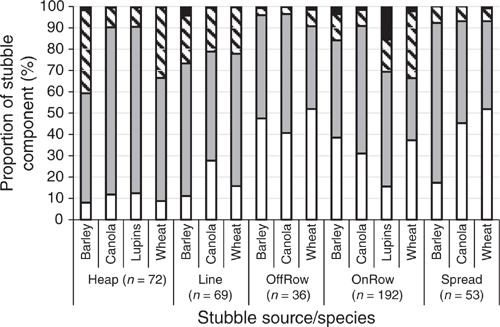
|
Metabolisable-energy content (derived from DMD) of the medium and small components was markedly higher than that of the large component (main stem), which had a correspondingly higher ADF content (Table 2, Fig. 5). The MEI for combined small and medium components was 1.1, 1.4, 1.7 and 2.6 MJ ME/kg DM higher than that for the large component, for barley, wheat, canola and lupins respectively (Table 2). Estimated ME and CP (N × 6.25) content was reasonably consistent within each species across the various chaff and standing-stubble samples for the medium component (Table 2, Fig. 6). However, the estimated ME content of the large and small components tended to be higher in heaps and lines (header chaff), than was the ME content of these components in samples taken using whole aboveground biomass cuts. This difference was ~0.5–1 MJ ME/kg DM higher in small or large material in chaff heaps and lines (Table 2).

|
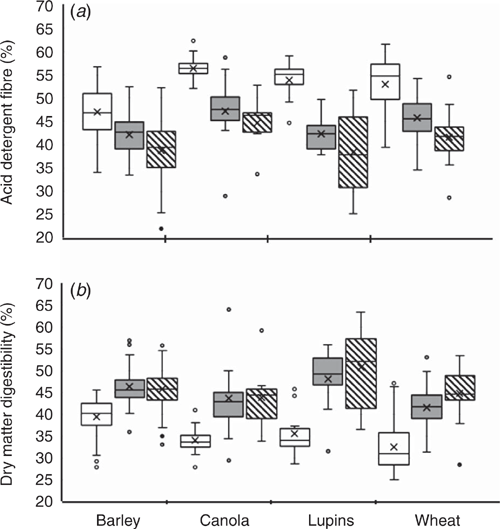
|
Barley and lupins tended to be of higher nutritive value across all components than were wheat and canola (Figs 5, 6). Trends and differences in N concentration among species and components were similar to those of the estimated ME content, although the correlation was generally lower for the medium component (e.g. estimated CP and ME correlation for wheat large, medium, small was r2 = 0.63, 0.36 and 0.62 respectively). This may be the result of medium material being more heterogenous, consisting of a wider range of plant components. There was no positive trend between CP and estimated ME content in the large canola component. For each of the crop species, there was no clear trend in nutritive value associated with growing-season rainfall.
Discussion
The present paper provides additional, updated information on the value of crop stubbles for grazing, and the potential use of header chaff for feed and fibre when combined with grains or fed in situ in stubble paddocks. Our field studies described the progressive decline in the grazing value of wheat stubbles, where sheep initially gain weight and then reach energy intake for maintenance after an average of 80 DSE grazing days/ha. The rapid depletion of stubble feed value is typical for the Mediterranean-type climates of southern Australia, where summer rainfall is infrequent and, where this does occur, green feed does not persist due to the high summer temperatures. For later-grazed stubbles (March–April), green feed in stubbles is of greater value with milder temperatures and as nutrients are lost due to leaching and other natural processes (Purser 1983; Landau et al. 2000). Overall, crop stubbles represent a highly variable and, therefore, complex source of feed, but are important in mixed farming at a time of high marginal value of feed (Ewing et al. 1989; Thomas et al. 2010a).
In general, our results were consistent with those of previous research where oat, then barley stubbles, were found to have higher nutritive-value components than were wheat stubbles (Table 3). Purser (1983) pointed to unharvested grain (which was not measured in their study) being important to the overall feeding value of stubble. Our data supported this, given the generally low nutritive value of chaff and straw, corresponding with the conclusion of Purser (1983, p. 25) that ‘theoretical calculations and experimental results show that whole crop stubble is less than maintenance for all classes of sheep at all locations’. In our field studies, sheep consistently gained weight, at least initially, when grazing stubbles; so, their ability to select grains and higher-quality components from the available forage cannot be understated. This has important implications for production, as livestock managers make decisions regarding the level of production required from the livestock and determine when to move animals to new sources of forage or provide supplementary feed. We have estimated, on the basis of the rate of depletion of grain in wheat stubbles, that ~50% of the ME consumed is from grain under typical stubble-grazing management.

|
Edible straw and chaff were mostly in the digestibility range of 40–50% or 5–7 MJ ME/kg DM, and the high variability among the samples and components suggests that the variability that was observed would be of practical importance for livestock production. Tests conducted ~20 years ago found that the estimated ME of cereal and canola chaff was 7.2–7.5 MJ/kg DM, which was substantially higher than our results (Roberts and Paterson 2001). Lupin chaff estimated ME values reported by Roberts and Paterson (2001) were also higher; however, relative differences were consistent with our results. ADF results were comparable, although the relationship between estimated ME and ADF appeared to differ, ~1 MJ/kg lower in our study for the same ADF value in Roberts and Paterson (2001; Fig. 7). Nitrogen concentration of stubbles measured in our survey was ~20–25% lower than has been reported in previous studies (Mulholland et al. 1976; Roberts and Paterson 2001). These results suggest there are Genetics × Environment × Management (G × E × M) factors in modern crop production that have resulted in decreases in the nutritive value of stubbles, that are independent of any changes in the amount of unharvested grains or weeds.
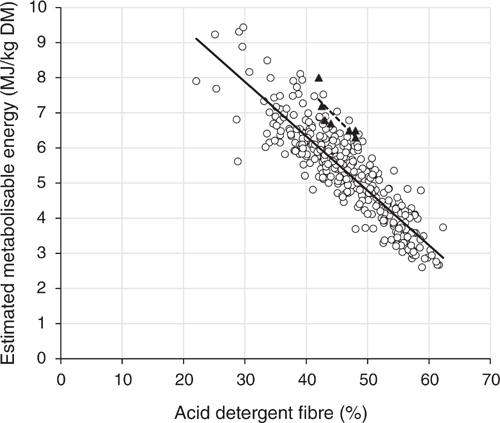
|
Observations of diet selection from stubbles in other studies have resulted in widely different results. For example, Mitchell (1979) found that sheep did not eat any stubble straw (main stem), while Arnold et al. (1978) reported that straw made up 90% of the sheep’s diet. We expect that crop stubbles that have components with a higher overall nutritive value (i.e. barley and oats) should enable sheep to select a proportionally higher-quality diet; however, to our knowledge, this hypothesis has not been tested. There is strong evidence in the literature for high selectivity and diversity in the diets of grazing ruminants (Daly 2009; Thomas et al. 2010b). Anecdotally, farmers consider barley stubbles to be of higher value than wheat stubbles, but whether this is due to higher levels of grain, the higher-quality stubble components, differences in the capacity of animals to select their preferred diet, or a combination of all these, is not known. Sheep actively select green pick in stubbles when it is available, Mulholland et al. (1976) found that sheep diets were over 80% green material where green biomass was higher than 40 kg/ha. While predicting the feeding value of stubbles remains a challenge, the skilful integration of research should improve the ability to manage feed budgeting with stubbles.
The type of livestock is also an important consideration in the management of grazing on stubbles. Due to the seasonal nature of sheep reproduction, ewes typically graze on stubbles during early pregnancy, which is a point during the season of low energy demand, relative to late pregnancy and lactation. Mature ewes are more likely to meet their energy and protein requirements when grazing stubbles than are younger stock, due to their lower energy and protein requirements and familiarity with grazing on stubbles. Research on young stock grazing stubbles found that they lost weight on stubbles when no grain supplement was provided, and that higher protein supplementation (lupins) produced substantially higher liveweights across the following growing season than did oat or barley supplements (Rowe et al. 1989). Ewes of a high body condition score (>4) were also likely to lose weight when grazing stubbles, compared with leaner ewes, which tended to maintain or gain weight, and this was likely to be associated with differences in energy requirements (Kenyon et al. 2014).
The results of stubble sampling and measurement of nutritive value highlighted the G × E × M interactions that exist, which contribute to high variability in nutritive value of stubble and chaff components. There were consistent differences among the three stubble fractions (large, medium and small) analysed. In particular, the digestibility of small and medium components was 6.5, 8.3, 9.9 and 14.9 percentage units higher than that of the large component (main stem), for barley, wheat, canola and lupins respectively. However, some of the results were inconsistent across samples from different chaff-manage methods, such as, for example, different trends in the estimated ME content of small and medium fractions in heaps compared with on-row samples, for barley, canola and lupins.
In the present study, we did not find any evidence that stubble quality was related to in-season rainfall, and the literature appears divided on this (Orsini and Arnold 1986). It is possible that other environmental factors, such as inland frost events and severe terminal drought, may confound the relationship between rainfall and stubble quality that has been observed in Western Australia (Purser 1983; Aitchison 1988). It is also possible that genetic selection for varieties more suited to the different environments, and improvements in crop-management practices over the past decades, have contributed. Significantly, there was an overall decrease in the nutritive value of stubbles (specifically crop-plant material) when compared with measurements that were made 20–45 years ago. Research to test the range of G × E × M interactions is needed to understand better drivers of forage nutritive value in stubbles.
Conflicts of interest
The authors declare no conflicts of interest.
Acknowledgements
The authors gratefully acknowledge Meat and Livestock Australia, Australian Wool Innovation and the CSIRO for funding this research. We thank the two anonymous reviewers for their valued suggestions and comments. This research would not have been possible without the generous support of WA farmers and grower groups.
References
Aitchison E (1988) Cereal straw and stubble as sheep feed. Journal of the Department of Agriculture, Western Australia 29, 96–101.Arnold GW, Wood PMcR, Nairn M, Allen J, Wallace SR, Weeldenberg J (1978) Comparison of lupin varieties for gain yield, nutritive value of stubbles, incidence of infection with Phomopsis leptostromiformis and occurrence of lupinosis. Australian Journal of Experimental Agriculture and Animal Husbandry 18, 442–452.
| Comparison of lupin varieties for gain yield, nutritive value of stubbles, incidence of infection with Phomopsis leptostromiformis and occurrence of lupinosis.Crossref | GoogleScholarGoogle Scholar |
Bell LW, Moore AD (2012) Integrated crop-livestock systems in Australian agriculture: trends, drivers and implications. Agricultural Systems 111, 1–12.
| Integrated crop-livestock systems in Australian agriculture: trends, drivers and implications.Crossref | GoogleScholarGoogle Scholar |
Brennan GA, Milton JTB, Norton BE, Krebs GL (2006) Rumen ecology driving productivity and landscape ecology in the shrublands of the West Australian rangelands. In ‘The cutting edge. Conference papers of the 14th biennial conference, Australian Rangeland Society’, Renmark, SA 3–7 September 2006. (Ed. P. Erkelenz) pp. 81–84. (Australian Rangeland Society: Perth)
CSIRO (2007) ‘Nutrient requirements of domesticated ruminants.’ (Eds M Freer, H Dove, JV Nolan) (CSIRO Publishing: Melbourne, Vic., Australia)
Daly FFM (2009) The effect of diet on the nutrition and production of Merino ewes in the arid shrublands of Western Australia. PhD Thesis, Curtin University, Perth, WA, Australia.
Ewing MA, Pannell DJ, Morrison DA (1989) Pastures and profit in an Australian ley farming system. In ‘Proceedings of the XVI international grassland congress’, Nice, France. (Ed. R. Jarrige) pp. 1349–1350. (Association Francaise pour la Production Fourragère: Nice, France)
Fischer RA (2008) Improvements in wheat yield: farrer, physiology and functional genomics. Agricultural Science 1/08, 6–18.
Fuchs C, Kasten J, Urbanek M (2015) Trends and potential of the market for combine harvesters in Germany. Machines 3, 364–378.
| Trends and potential of the market for combine harvesters in Germany.Crossref | GoogleScholarGoogle Scholar |
Kenyon PR, Maloney SK, Blache D (2014) Review of sheep body condition score in relation to production characteristics. New Zealand Journal of Agricultural Research 57, 38–64.
| Review of sheep body condition score in relation to production characteristics.Crossref | GoogleScholarGoogle Scholar |
Kernan JA, Crowle WL, Spurr DT, Coxworth EC (1979) Straw quality of cereal cultivars before and after treatment with anhydrous ammonia. Canadian Journal of Animal Science 59, 511–517.
| Straw quality of cereal cultivars before and after treatment with anhydrous ammonia.Crossref | GoogleScholarGoogle Scholar |
Landau S, Perevolotsky A, Bonfil D, Barkai D, Silanikove N (2000) Utilization of low-quality resources by small ruminants in Mediterranean agro-pastoral systems: the case of browse and aftermath cereal stubble. Livestock Production Science 64, 39–49.
| Utilization of low-quality resources by small ruminants in Mediterranean agro-pastoral systems: the case of browse and aftermath cereal stubble.Crossref | GoogleScholarGoogle Scholar |
Mitchell ME (1979) Honours Thesis. The University of Western Australia.
Moore AD, Holzworth DP, Herrmann NI, Huth NI, Robertson MJ (2007) The Common Modelling Protocol: a hierarchical framework for simulation of agricultural and environmental systems. Agricultural Systems 95, 37–48.
Mulholland JG, Coombe JB, Freer M, McManus WR (1976) Evaluation of cereal stubbles for sheep production. Australian Journal of Agricultural Research 27, 881–893.
| Evaluation of cereal stubbles for sheep production.Crossref | GoogleScholarGoogle Scholar |
Norman HC, Wilmot MG, Thomas DT, Barrett-Lennard EG, Masters DG (2010) Sheep production, plant growth and nutritive value of a saltbush-based pasture system subject to rotational grazing or set stocking. Small Ruminant Research 91, 103–109.
| Sheep production, plant growth and nutritive value of a saltbush-based pasture system subject to rotational grazing or set stocking.Crossref | GoogleScholarGoogle Scholar |
Orsini JPG (1990) SummerPak: a user-friendly simulation software for the management of sheep grazing dry pastures or stubbles. Agricultural Systems 33, 361–376.
| SummerPak: a user-friendly simulation software for the management of sheep grazing dry pastures or stubbles.Crossref | GoogleScholarGoogle Scholar |
Orsini JPG, Arnold GW (1986) Predicting the liveweight changes of sheep grazing wheat stubble in a Mediterranean environment. Agricultural Systems 20, 83–103.
| Predicting the liveweight changes of sheep grazing wheat stubble in a Mediterranean environment.Crossref | GoogleScholarGoogle Scholar |
Pearce GR, Beard J, Hilliard EP (1979) Variability in the chemical composition of cereal straws and in vitro digestibility with and without sodium hydroxide treatment. Australian Journal of Experimental Agriculture 19, 350–353.
| Variability in the chemical composition of cereal straws and in vitro digestibility with and without sodium hydroxide treatment.Crossref | GoogleScholarGoogle Scholar |
Pickup G, Stafford Smith DM (1993) Problems, prospects and procedures for assessing sustainability of pastoral land management in arid Australia. Journal of Biogeography 20, 471–487.
| Problems, prospects and procedures for assessing sustainability of pastoral land management in arid Australia.Crossref | GoogleScholarGoogle Scholar |
Purser DB (1983) The nutritional value of stubbles. In ‘Stubble utilization’. pp. 13–26. (Rural and Allied Industries: Perth, WA, Australia)
Roberts D, Paterson J (2001) Sheep performance on cereal and canola stubbles. In ‘The good food guide for sheep. Bulletin 4473’. (Eds K Croker, P Watt) pp. 52–60. (Department of Agriculture: Perth, WA, Australia)
Robertson SM (2006) Crop stubbles are as important for sheep production as annual pastures in the Victorian Mallee. Australian Journal of Experimental Agriculture 46, 993–1003.
| Crop stubbles are as important for sheep production as annual pastures in the Victorian Mallee.Crossref | GoogleScholarGoogle Scholar |
Rossiter RC (1966) Ecology of the mediterranean annual-type pasture. Advances in Agronomy 18, 1–56.
| Ecology of the mediterranean annual-type pasture.Crossref | GoogleScholarGoogle Scholar |
Rowe JB, Brown G, Ralph IG, Ferguson J, Wallace JF (1989) Supplementary feeding of young Merino sheep, grazing wheat stubble, with different amounts of lupin, oat and barley grain. Australian Journal of Experimental Agriculture 29, 29–35.
Thomas DT, White CL, Hardy J, Collins J-P, Ryder A, Norman HC (2009) An on-farm evaluation of the capability of saline land for livestock production in southern Australia. Animal Production Science 49, 79–83.
| An on-farm evaluation of the capability of saline land for livestock production in southern Australia.Crossref | GoogleScholarGoogle Scholar |
Thomas DT, Finlayson J, Moore AD, Robertson MJ (2010a) Profitability of grazing crop stubbles may be over-estimated by using the metabolisable energy intake from the stubble. Animal Production Science 50, 699–704.
| Profitability of grazing crop stubbles may be over-estimated by using the metabolisable energy intake from the stubble.Crossref | GoogleScholarGoogle Scholar |
Thomas DT, Milton JTB, Revell CK, Ewing MA, Dynes RA, Murray K, Lindsay DR (2010b) Preference of sheep among annual legumes is more closely related to plant nutritive characteristics as plants mature. Animal Production Science 50, 114–123.
| Preference of sheep among annual legumes is more closely related to plant nutritive characteristics as plants mature.Crossref | GoogleScholarGoogle Scholar |
Walsh M, Ouzman J, Newman P, Powles S, Llewellyn R (2017) High levels of adoption indicate that harvest weed seed control is now an established weed control practice in Australian cropping. Weed Technology 31, 341–347.
| High levels of adoption indicate that harvest weed seed control is now an established weed control practice in Australian cropping.Crossref | GoogleScholarGoogle Scholar |
Wilkinson I (2017) ‘Western Australian canola industry.’ (Department of Primary Industries and Regional Development Western Australia) Available at https://www.agric.wa.gov.au/canola/western-australian-canola-industry [Verified 19 August 2020]


